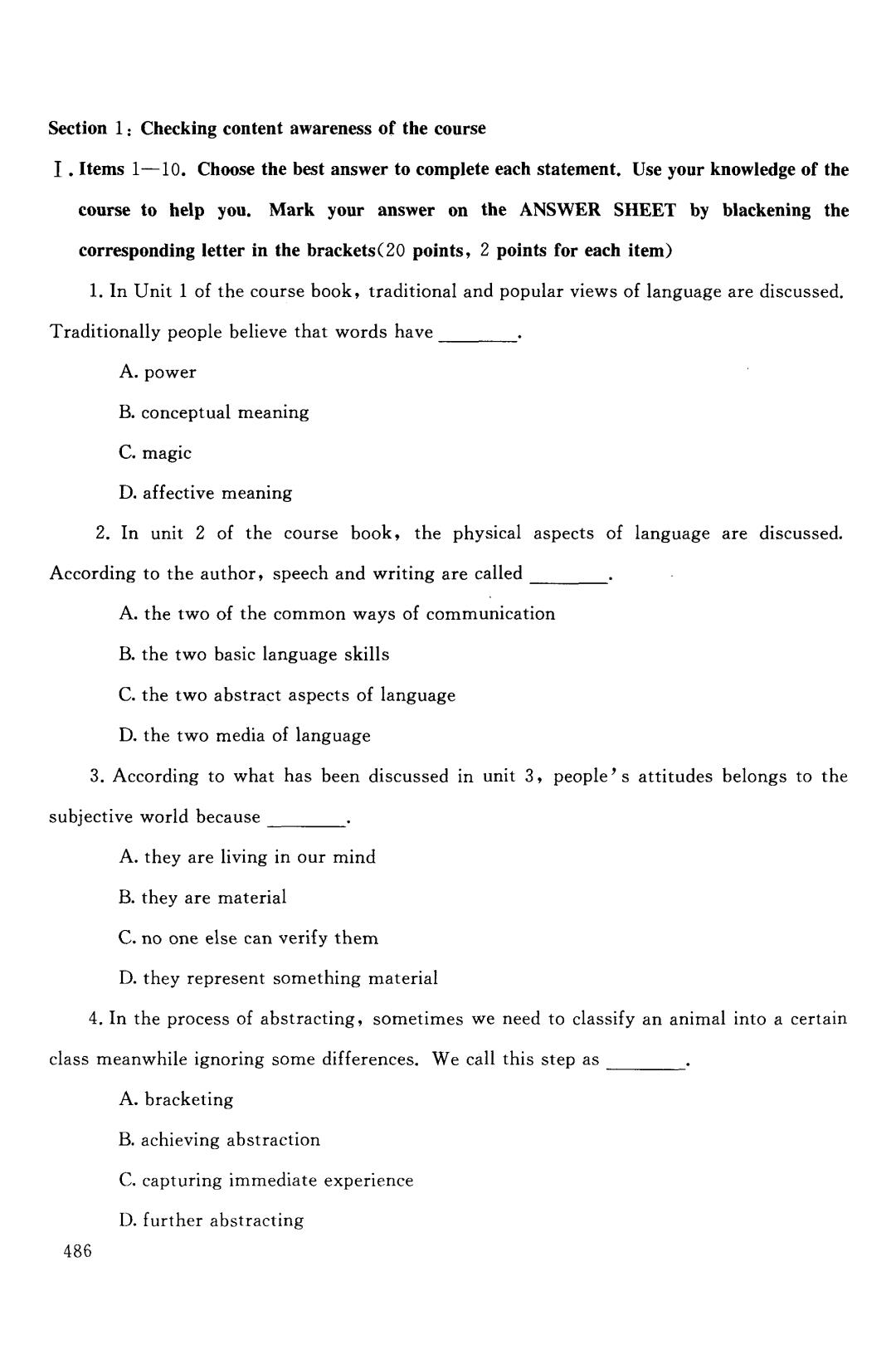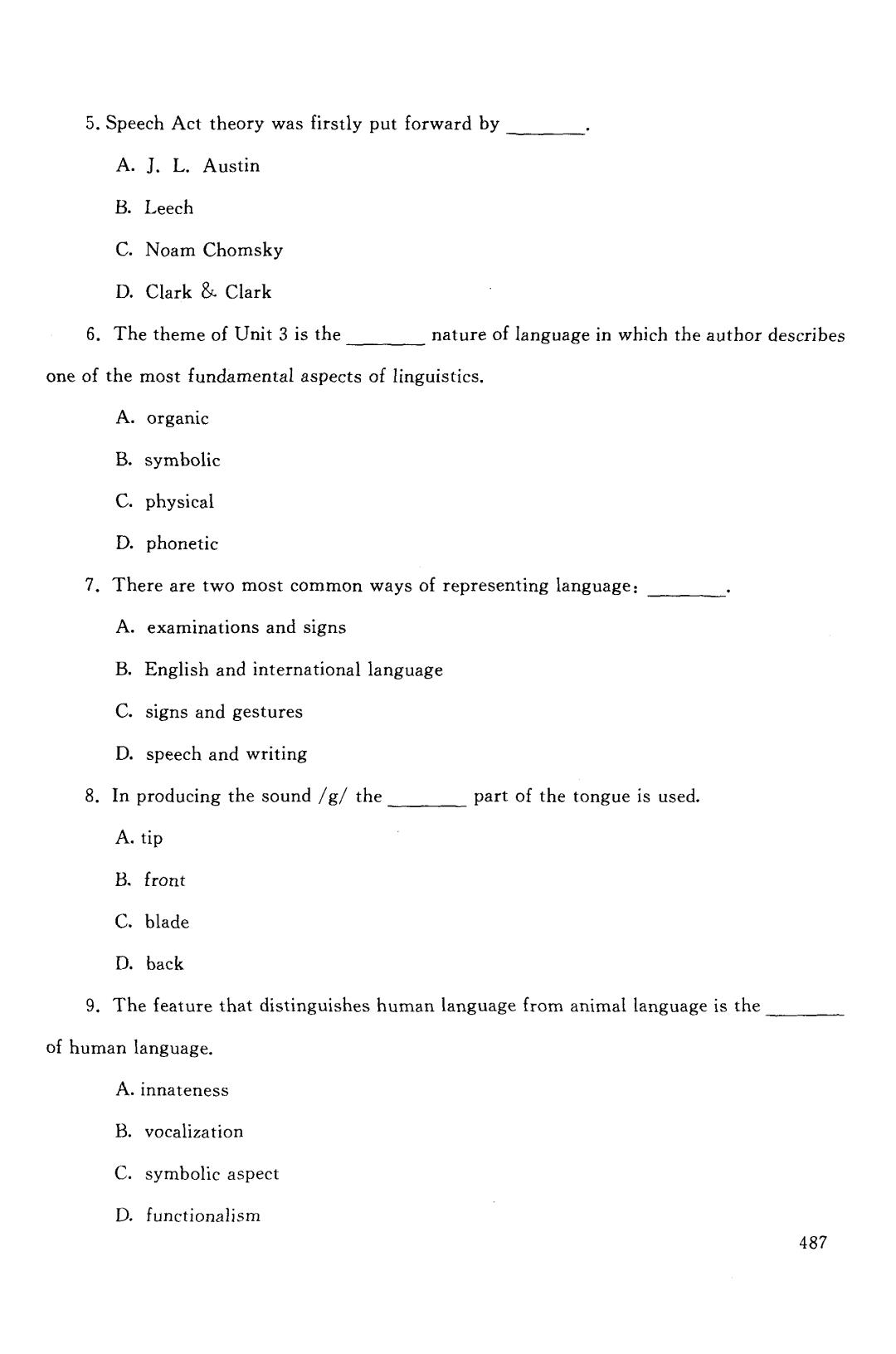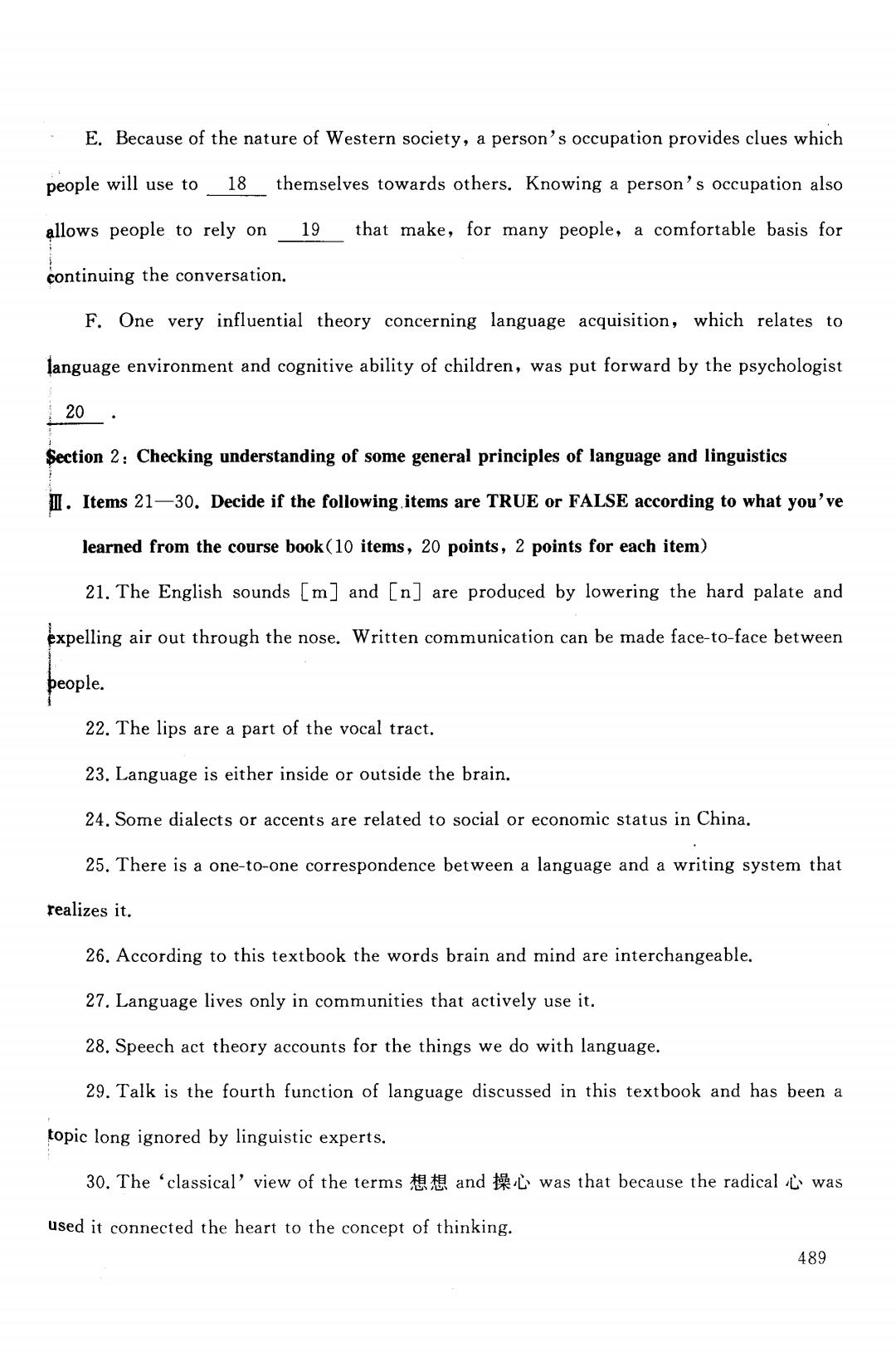
试卷代号:1066 中央广播电视大学2009一2010学年度第二学期“开放本科”期末考试 语言与应用语言学试题 2010年7月 注意事项 一、将你的学号、姓名及分校(工作站)名称填写在答题纸的规定栏 内。考试结束后,把试卷和答题纸放在桌上。试卷和答题纸均不得带 出考场。 二、仔细阅读题目的说明,并按题目要求答题。答案一定要写在答 题纸指定的位置上,写在试卷上的答案无效。 三、用蓝、黑圆珠笔或钢笔答题,使用铅笔答题无效。 You have 90 minutes to finish this exam. The exam consists of 3 sections: Section 1 Checking content awareness of the course I.Multiple Choice Questions (10 items,20 points,2 points for each item) II.Gap-filling (10 items,20 points,2 for each item) Section 2 Checking understanding of some general principles of language and linguistics III.True or False Questions (10 items,20 points,2 points for each item) IV.Matching (10 items,20 points,2 points for each item) Section 3 Checking analytic application (1 item,20 points) V.One analytic question about some linguistic phenomena This is a closed exam.You are not allowed to consult any reference books or with other examinees. 485
试卷代号 6 6 中央广播电视大学 0 0 2010 学年度第二学期 末考试 语言与应用语言学试题 2010 年7 注意事项 一、将你的学号、姓名及分校(工作站)名称填写在答题纸的规定栏 内。考试结束后,把试卷和答题纸放在桌上。试卷和答题纸均不得带 出考场。 二、仔细阅读题目的说明,并按题目要求答题。答案一定要写在答 题纸指定的位置上,写在试卷上的答案无效。 三、用蓝、黑圆珠笔或钢笔答题,使用铅笔答题无效。 • You have 90 minutes to finish this exam. • The exam consists of 3 sections: Section 1 : Checking content awareness of the course I. Multiple Choice Questions (10 items , 20 points, 2 points for each item) II. Gap-filling (1 0 items, 20 points, 2 for each item) Section 2 : Checking understanding of some general principles of language and linguistics III. True or False Questions (10 items, 20 points, 2 points for each item) N. Matching (1 0 items, 20 points , 2 points for each item) Section 3 : Checking analytic application (1 item , 20 points) v. One analytic question about some linguistic phenomena • This is a closed exam. You are not allowed to consult any reference books or with other examinees. 485

Section 1:Checking content awareness of the course I.Items 1-10.Choose the best answer to complete each statement.Use your knowledge of the course to help you.Mark your answer on the ANSWER SHEET by blackening the corresponding letter in the brackets(20 points,2 points for each item) 1.In Unit 1 of the course book,traditional and popular views of language are discussed. Traditionally people believe that words have_ A.power B.conceptual meaning C.magic D.affective meaning 2.In unit 2 of the course book,the physical aspects of language are discussed. According to the author,speech and writing are called A.the two of the common ways of communication B.the two basic language skills C.the two abstract aspects of language D.the two media of language 3.According to what has been discussed in unit 3,people's attitudes belongs to the subjective world because_ A.they are living in our mind B.they are material C.no one else can verify them D.they represent something material 4.In the process of abstracting,sometimes we need to classify an animal into a certain class meanwhile ignoring some differences.We call this step as A.bracketing B.achieving abstraction C.capturing immediate experience D.further abstracting 486
Section 1: Checking content awareness of the course I . Items 1-10. Choose the 臼t answer to complete each statement. Use your knowledge of the course to help you. Mark your answer on the ANSWER SHEET by blackening the corresponding letter in the bracketsC20 points, 2 points for each item) 1. In Unit 1 of the course book , traditional and popular views of language are discussed. Traditionally people believe that words have A. power B. conceptual meaning C. magic D. affective meaning 2. In unit 2 of the course book , the physical aspects of language are discussed. According to the author, speech and writing are called A. the two of the common ways of communication B. the two basic language skills C. the two abstract aspects of language D. the two media of language 3. According to what has been discussed in unit 3 , people' s attitudes belongs to the subjective world because A. they are living in our mind B. they are material C. no one else can verify them D. they represent something material 4. In the process of abstracting , sometimes we need to classify an animal into a certain class meanwhile ignoring some differences. We call this step as A. bracketing B. achieving abstraction C. capturing immediate experience D. further abstracting 486

5.Speech Act theory was firstly put forward by A.J.L.Austin B.Leech C.Noam Chomsky D.Clark Clark 6.The theme of Unit 3 is the nature of language in which the author describes one of the most fundamental aspects of linguistics. A.organic B.symbolic C.physical D.phonetic 7.There are two most common ways of representing language: A.examinations and signs B.English and international language C.signs and gestures D.speech and writing 8.In producing the sound /g/the part of the tongue is used. A.tip B.front C.blade D.back 9.The feature that distinguishes human language from animal language is the of human language. A.innateness B.vocalization C.symbolic aspect D.functionalism 487
5. Speech Act • theory was firstly put forward by A. J. L. Austin B. Leech C. Noam Chomsky D. Clark & Clark 6. The theme of Unit 3 is the nature of language in which the author describes one of the most fundamental aspects of linguistics. A. organic part of the tongue is used. B. symbolic C. physical D. phonetic 7. There are two most common ways of representing language: A. examinations and signs B. English and internationallanguage C. signs and gestures D. speech and writing 8. In producing the sound / g/ the A. tip B. front • C. blade D. back 9. The feature that distinguishes human language from animal language is the of human language. A. innateness B. vocalization C. symbolic aspect D. functionalism 487

10.A functional analysis of language studies A.what sort of things language helps us to do B.how language helps to define national identities C.how we organize our experience through language D.how we manage interpersonal relationships through language II.Items 11-20.Choose those words or phrases that best complete the following sentences. Mark your answer on the ANSWER SHEET.Note that there are more words or phrases than necessary.(Box A is for items 11-15,and Box B for items 16-20.20 points,2 points for each item) Box A Box B A.maxims G.cognitive B.artificial intelligence H.homo sapiens C.orient I.homo habilis D.Piaget J.Lenneberg E.norms K.classification F.language L.stereotypes A.Professor Guide (in Unit 1)makes the major point that the possession of 11 by 12 has contributed to civilized and meaningful living. B.Research into how to make machines understand meaning is called the study of 13· C.When we name things it involves an act of 14.This act is not neutral therefore there are social as well as 15 repercussions. D.Chinese values associated with politeness are called 16.These are social 17 that govern social exchanges. 488
10. A functional analysis of language studies • 0, nyQU U QU O G l e'h anubuagb l ngbQU O +L ozi ··n·1 a QU A w.'n B. how language helps to define national identities C. how we organize our experience through language D. how we manage interpersonal relationships through language II. Items 11 一20. Choose those words or phrases that best complete the following sentences. Mark your answer on the ANSWER SHEET. Note that there are more words or phras than necessary. (Box A is for items 11 一15 and Box B for items 16-20. 20 points, 2 points for each item) Box A Box B A. maxims G. cognitive B. artificial intelligence H. homo sapiens C. orient I. homo habilis D. Piaget J. Lenneberg E. norms K. classification F. language L. stereotypes A. Professor Guide (in Unit 1) makes the major point that the possession of 11 by 12 has contributed to civilized and meaningful living. B. Research into how to make machines understand meaning is called the study of 13 • C. When we name things it involves an act of 14 . This act is not neutral therefore there are social as well as 15 repercussIOns. D. Chinese values associated with politeness are called 16 . These are social 17 that govern social exchanges. 488

E.Because of the nature of Western society,a person's occupation provides clues which people will use to 18 themselves towards others.Knowing a person's occupation also allows people to rely on 19 that make,for many people,a comfortable basis for continuing the conversation. F.One very influential theory concerning language acquisition,which relates to language environment and cognitive ability of children,was put forward by the psychologist 20· Section 2:Checking understanding of some general principles of language and linguistics I.Items 21-30.Decide if the following.items are TRUE or FALSE according to what you've learned from the course book(10 items,20 points,2 points for each item) 21.The English sounds [m]and [n]are produced by lowering the hard palate and expelling air out through the nose.Written communication can be made face-to-face between people. 22.The lips are a part of the vocal tract. 23.Language is either inside or outside the brain. 24.Some dialects or accents are related to social or economic status in China. 25.There is a one-to-one correspondence between a language and a writing system that realizes it. 26.According to this textbook the words brain and mind are interchangeable. 27.Language lives only in communities that actively use it. 28.Speech act theory accounts for the things we do with language. 29.Talk is the fourth function of language discussed in this textbook and has been a topic long ignored by linguistic experts. 30.The‘classical'view of the terms想想and操心was that because the radical心was used it connected the heart to the concept of thinking. 489
E. Because of the nature of Western society , a person' s occupation provides clues which people will use to 18 themselves towards others. Knowing a person' s occupation also people to rely on 19 that make , for many people , a comfortable basis for F. One very influential theory concerning language acquisition , which relates to language environment and cognitive ability of children , was put forward by the psychologist 20 • $ection 2: Checking understanding of some general principles of language and linguistics 噩. Items 21-30. Decide if the following .items are TRUE or FALSE according to what you've learned from the course book(lO items, 20 points, 2 points for each item) 21. The English sounds [m] and [n] are produced by lowering the hard palate and ~xpelling air out through the nose. Written communication can be made face-to-face between eople. 22. The lips are a part of the vocal tract. 23. Language is either inside or outside the brain. 24. Some dialects or accents are related to social or economic status in China. 25. There is a one-to-one correspondence between a language and a writing system that tealizes it. 26. According to this textbook the words brain and mind are interchangeable. 27. Language lives only in communities that actively use it. 28. Speech act theory accounts for the things we do with language. 29. Talk is the fourth function of language discussed in this textbook and has been a ~opic long ignored by linguistic experts. 30. The ‘ classical ' view of t he terms 想and 心was that because the radical 心was used it connected the heart to the concept of thinking. 489